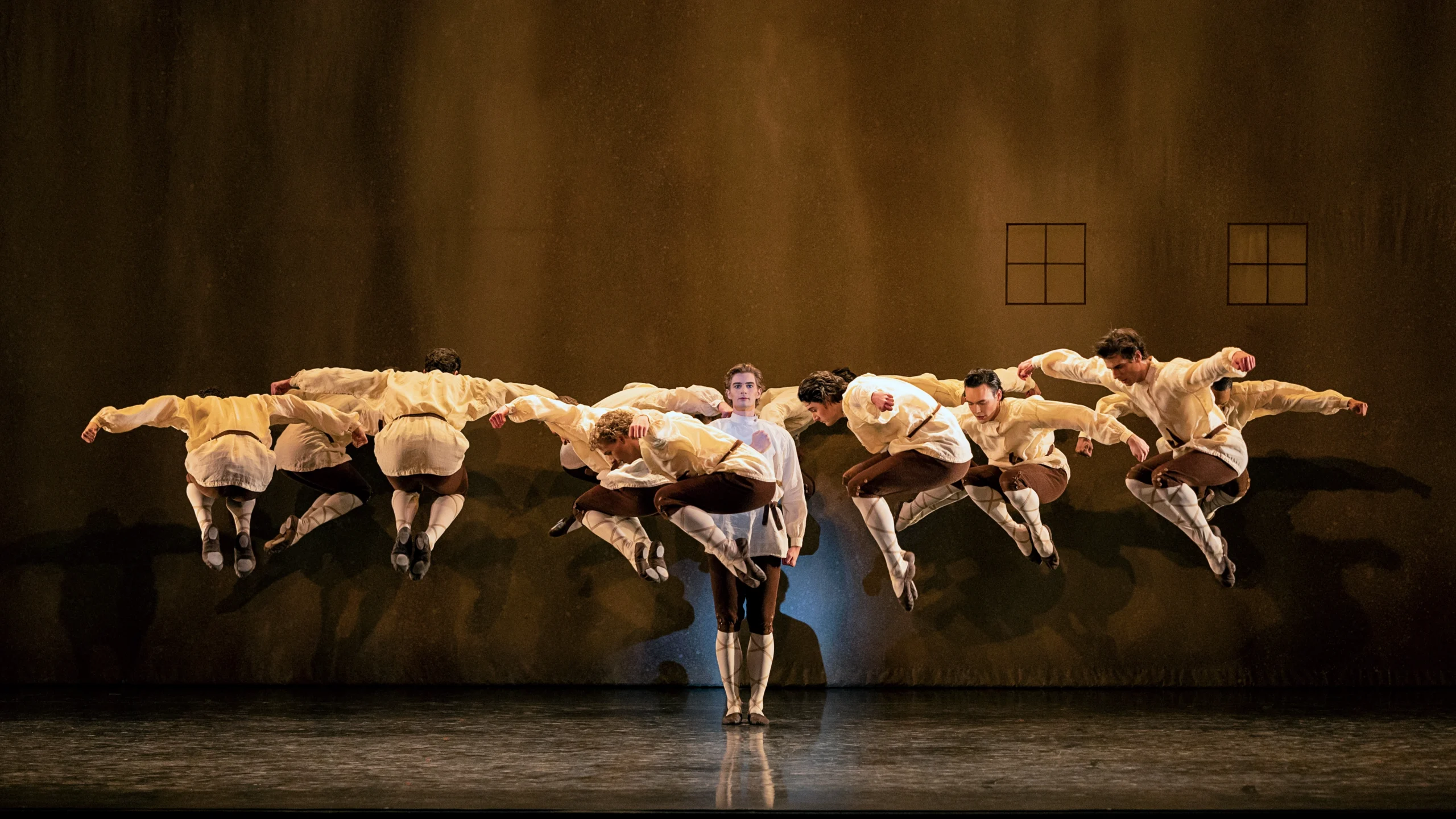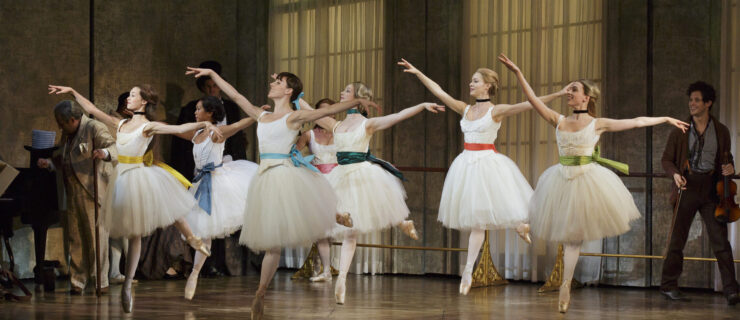12 Standout Performances of 2023
The year’s end is a fantastic time to celebrate the hard work that dancers and ballet companies have been doing onstage. Here are 12 standout performances our writers have seen and loved in 2023, listed in chronological order. They range from exuberant solos to major ensemble works, from premieres to revivals, and even a film. Of course, our writers can’t see everything, so stay tuned for readers’ favorites later this week!
San Francisco Ballet in MADCAP
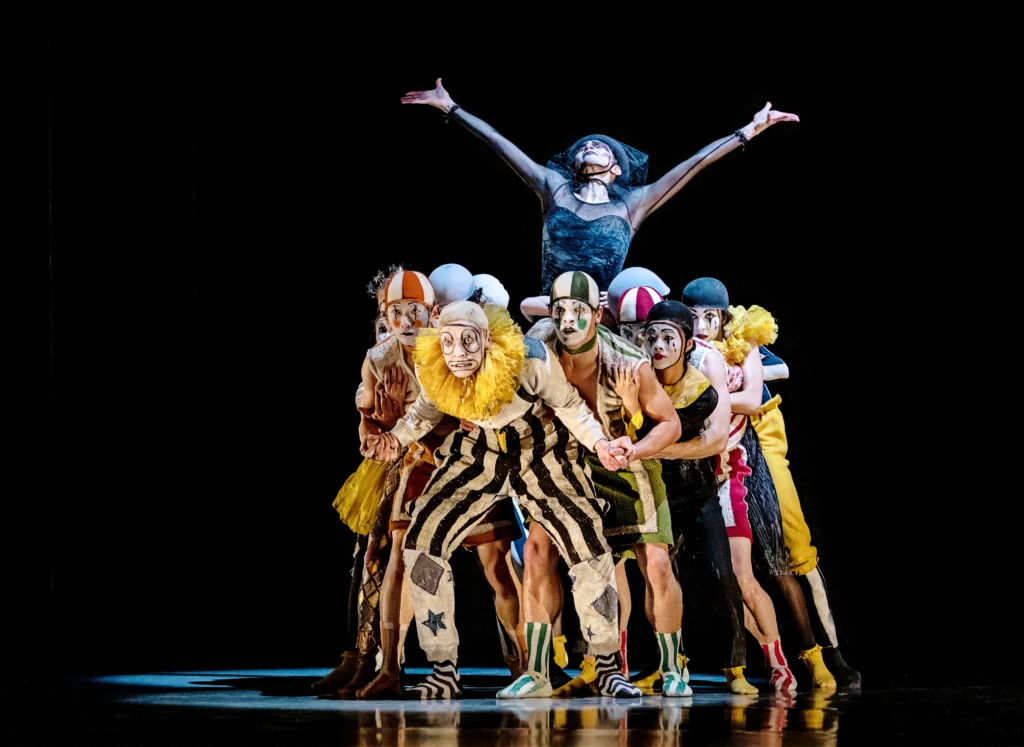
San Francisco Ballet’s next@90 Festival brought a feast of world premieres last January. But the most memorable, at least to this viewer, was far and wide Danielle Rowe’s MADCAP. The ballet opens onto a dark and saggy traveling circus. Tiit Helimets, in his final role as principal dancer after a long career at SFB, played the central, sad-sack clown whose outer façade is stripped away by his fellow band of wild and menacing buffoons.
Rowe’s movement vocabulary is wide-ranging—jaunty, fluid, heavy, speedy—and SFB’s superb dancers took to it effortlessly. The commanding Jennifer Stahl, as master of ceremonies, was both sternly motherly and cruel, narrating events aloud. Dancers spontaneously burst into song or maniacal laughter, climbing and piling onto each other in large clumps. Their commitment, combined with Emma Kingsbury’s designs, Jim French’s lighting, and Pär Hagström’s arranged, circus-inspired score, brought this strange and sinister cirque-universe to life. But it was Helimets, utterly vulnerable as his character is forced to unmask, who gave the ballet its heart. —Amy Brandt
Grand Rapids Ballet’s Yuka Oba-Muschiana and Josué Justiz in Romeo and Juliet
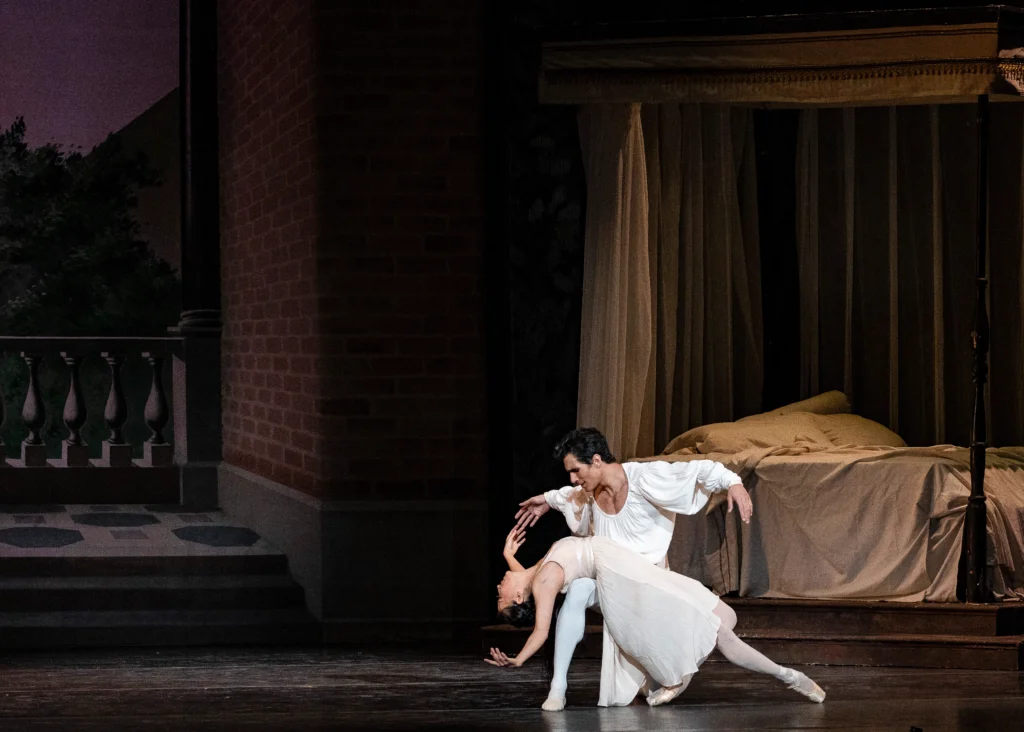
Grand Rapids Ballet artistic director James Sofranko couldn’t have asked for better lead characters for the premiere of his first full-length, Romeo and Juliet, this past February. Veteran company dancers Yuka Oba-Muschiana and Josué Justiz brought refined technique, believability, and spellbinding chemistry to their portrayals of Shakespeare’s star-crossed lovers.
From the moment their eyes met at the Capulet ball, the two seemed driven by an all-consuming need for one another. That was most evident in Act I’s closing balcony scene, when Oba-Muschiana’s Juliet outstretched an arm in a plea to the heavens to deliver Romeo to her. And when it did, the pair, under the starlit sky of the Capulets’ garden, danced a sweeping pas de deux with euphoric abandon, replete with love’s delirium.
Throughout Sofranko’s captivating production, Justiz and Oba-Muschiana elicited smiles and raced pulses from the audience, and tugged at their heartstrings. In the ballet’s final moments, when the poison of expectation ended their characters’ lives, Justiz and Oba-Muschiana’s performances proved magnificently riveting. —Steve Sucato
National Ballet of Canada in David Dawson’s Anima Animus
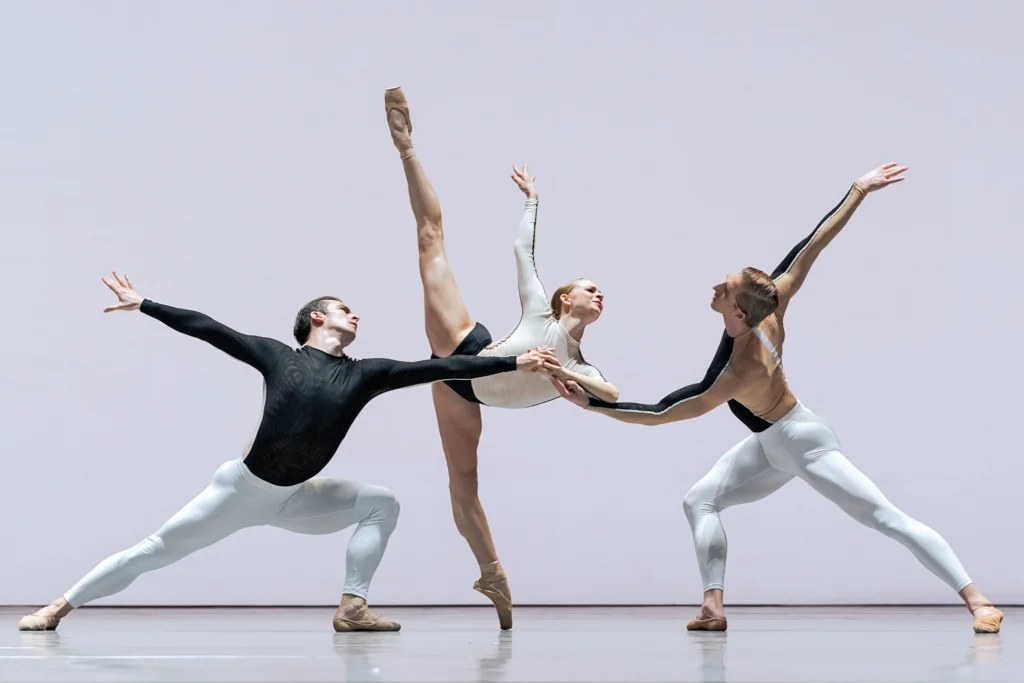
The National Ballet of Canada made David Dawson’s 2018 ballet Anima Animus their own with an elegant yet blistering opening-night performance on March 3 in Toronto. Part of a mixed program, along with Balanchine’s Symphony in C and Rena Butler’s Alleged Dances, Dawson’s 30-minute ballet uses contrast, opposition, counterpoint, and attack to explore Carl Jung’s ideas of the collective unconscious. Fittingly, the ensemble work here was flawlessly precise—it had to be at the rapid pace Dawson and the score (Ezio Bosso’s “Violin Concerto No. 1”) requires. As might be expected for a choreography with gendered subtexts, the dancing flirted with androgyny, sparking intriguing groupings and bravura bursts of brilliance from all 10 dancers. It was a perfect showcase for some of NBoC’s powerful rising stars, including Calley Skalnik, Genevieve Penn Nabity, and Spencer Hack. In a joyful ambush at curtain call, Hope Muir promoted a stunned Hack to principal dancer as the assembled cheered onstage and off. —Kathleen Smith
Sarasota Ballet’s Ricki Bertoni in La Sylphide

To be a standout performer, being a good dancer isn’t enough. For Ricki Bertoni, character principal at The Sarasota Ballet, it’s almost beside the point. Bertoni’s thoughtful, original dramatic takes on pivotal roles have held together the company’s narrative repertory. Last season, Bertoni channeled Robert Helpmann in an over-the-top performance as the Child of Darkness in Frederick Ashton’s Dante Sonata. But he’s strong in more than British one-acters. In Balanchine’s Western Symphony in April, he played the second movement like a cowboy movie extra who found himself starring in a ballet; it wasn’t quite like any version I’d seen, and yet it worked.
This year’s standout was Madge in La Sylphide, which the company performed in March. Bertoni’s approach to the antagonist witch wasn’t caricature, but human and understandable. When Madge played with a poisoned scarf, tossing it but also caressing it against her face, alternately vengeful and sensual, all the contradictions of kindness and brutality were there.
Character dancers get too little love and attention; yet without them story ballets have no story. Bertoni’s portrayals have made him one of the most precious assets in a jewel box company. —Leigh Witchel
Ballet West in Les Noces
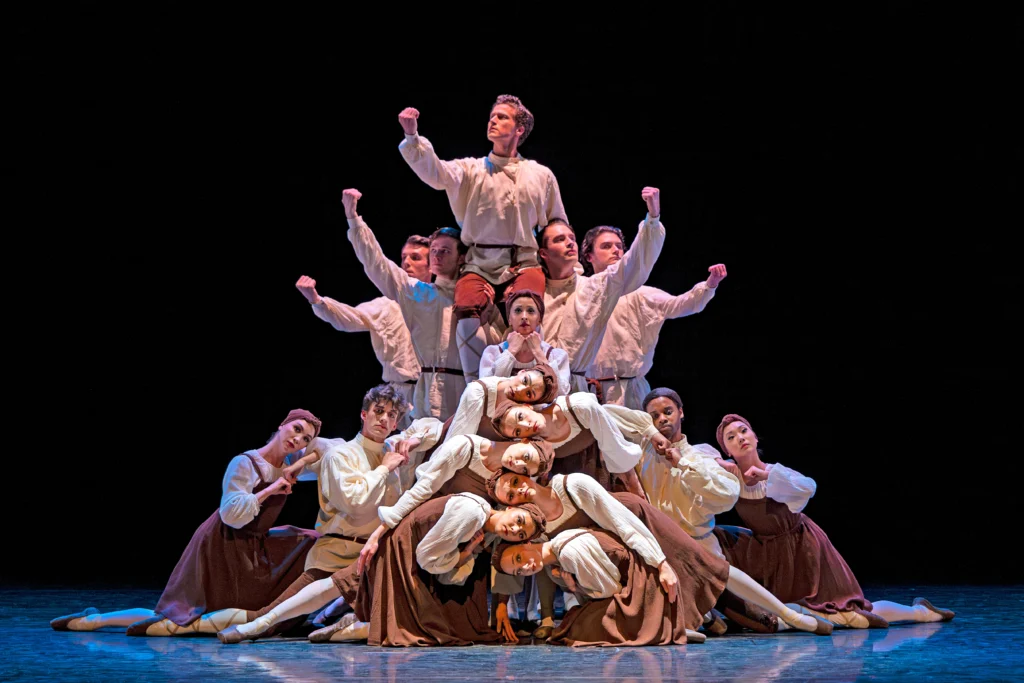
Ballet West’s 100th anniversary restaging of Bronislava Nijinska’s masterful Les Noces came at just the right time: a moment when companies are being pushed to foster and honor female choreographic voices, and shortly after the release of La Nijinska, Lynn Garafola’s definitive biography of the Diaghilev-era choreographer. With a two-weekend run at Salt Lake City’s Capitol Theatre in April, plus a Works & Process event at the Guggenheim Museum in New York City in March, the Salt Lake City–based company brought this influential—though not often performed—work to many audiences. The dancers themselves excelled, too, paring back virtuosity to depict an arranged marriage in a Russian peasant community, and capturing Nijinska’s stark style and somber intimations. With a cast of 38 dancers, a chorus, four vocal soloists, and four pianists, the company’s performances were a testament to its capacity to excel in increasingly demanding and complex work. Les Noces was presented as part of a triple bill, also featuring Jerome Robbins’ In the Night and Gerald Arpino’s Light Rain, further emphasizing Ballet West’s impressive breadth and depth. —Sophie Bress
Dance Theatre of Harlem’s Daphne Marcelle Lee in Sounds of Hazel
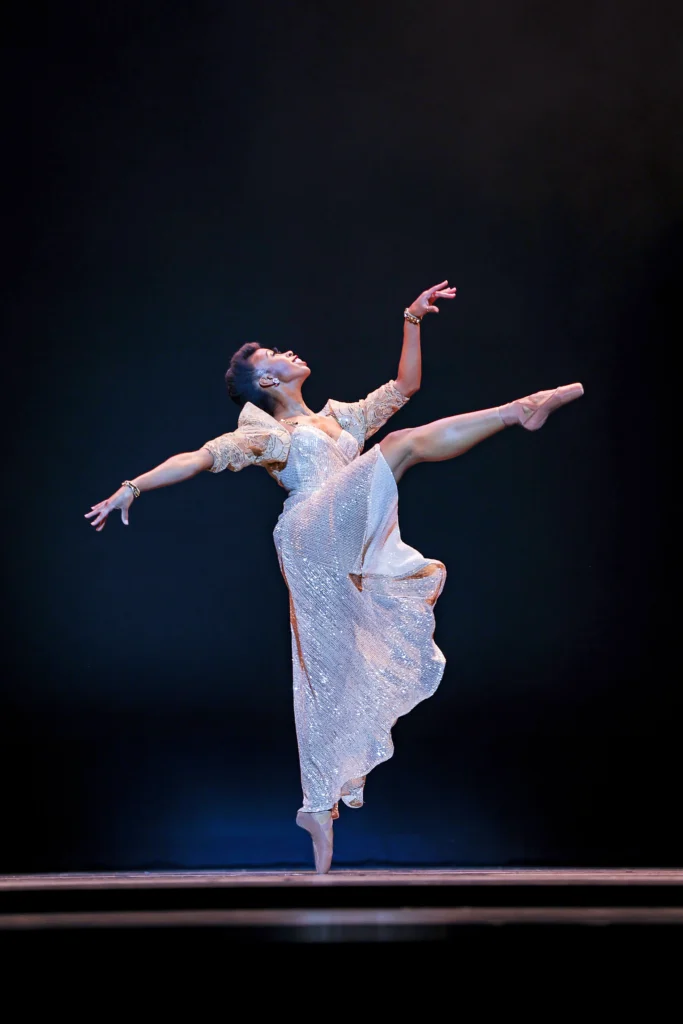
Applause broke out the moment Dance Theatre of Harlem’s Daphne Marcelle Lee took the stage in the second vignette solo of Tiffany Rea Fischer’s Sounds of Hazel last April. Lee, a company veteran and audience favorite, was the consummate entertainer in the title role of piano virtuoso Hazel Scott. In a glittering dress by costume designer Mark Zappone, she shone with even brighter wattage. Every hip roll was pure honey, and her joy projected to each corner of the packed New York City Center theater. If Hazel Scott’s gift was music, Lee’s is some kind of magic. She transported her audience directly into a smoke-filled, 1920s jazz hall, her effortless chassés eating up the stage and rapturous fingertips air-playing to Scott’s famous rendition of Chopin’s “Minute Waltz.” Her electrifying performance marked her last with DTH—these days, audiences can see her in The Lion King on Broadway. —Hannah Foster
Scottish Ballet in Helen Pickett’s The Crucible
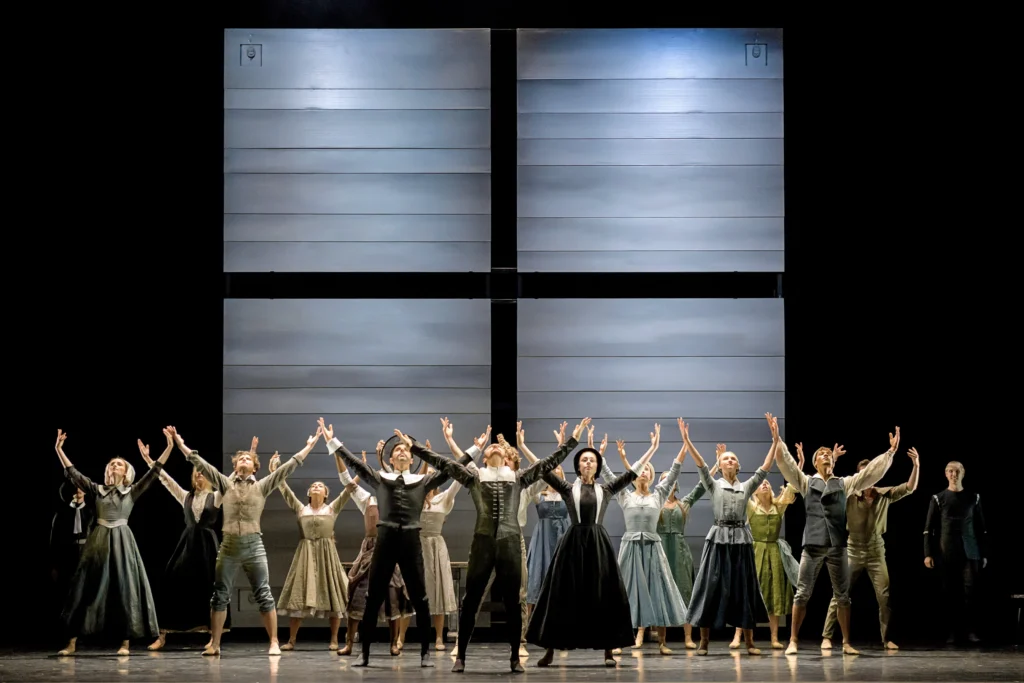
Scottish Ballet’s raw and emotive performance of Helen Pickett’s The Crucible, based on Arthur Miller’s play of the same name, stunned audiences at Washington, DC’s Kennedy Center last May. While many narrative ballets feature elaborate sets and costumes, this production’s minimalist, utilitarian approach mirrors the Puritan ideology emphasizing simple living. Similarly, its starkness forced audience members to lean into the emotions portrayed in Pickett’s choreography, without distraction.
A tale of lust, love, and hysteria, The Crucible follows Abigail Williams, John Proctor, and his wife, Elizabeth, in a love triangle set against the mania of the Salem witch trials. Principal Marge Hendrick, in the role of Elizabeth Proctor at the performance I attended, made the complicated emotions that come with loving someone despite their betrayal concrete with each step. The chemistry she shared with Evan Loudon’s John Proctor was palpable. But as much detail was given to the group dances, which were equally vital in moving the narrative forward. Jerky movements articulate the undercurrent of madness, and one of the most haunting elements of this production are the dancers’ reoccurring laughter and screams at pivotal moments. While The Crucible may not boast the feel-good, ethereal appeal that traditional story ballets evoke, it is a must-see ballet that will awaken the senses. —Katherine Beard
Flower, by Misty Copeland’s Life in Motion Productions
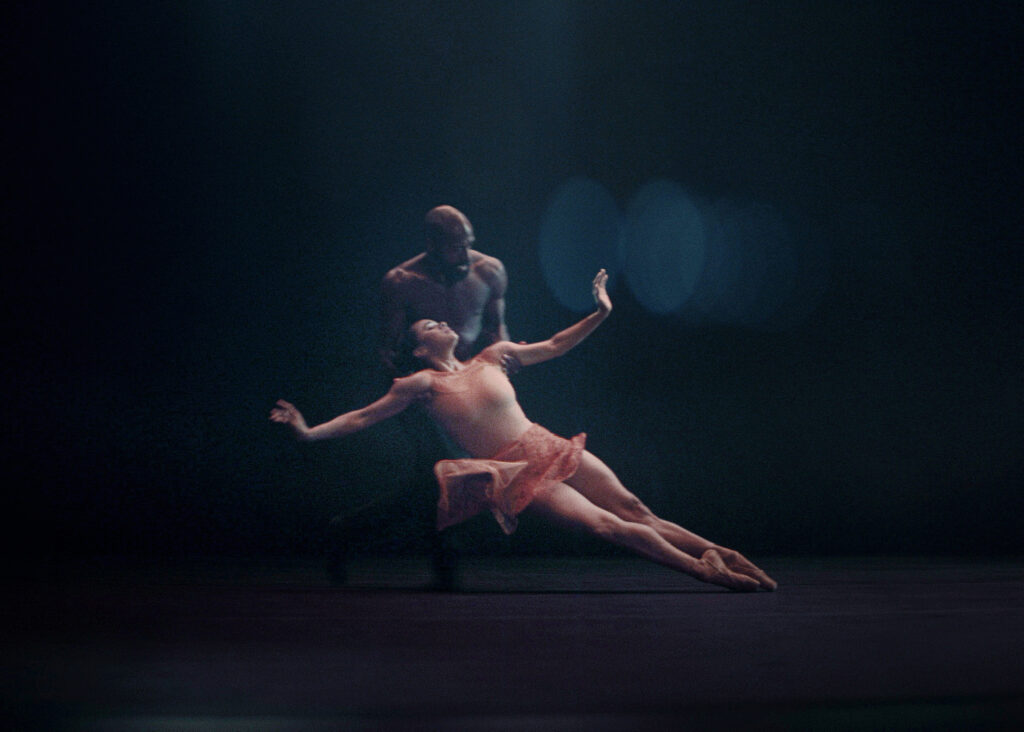
The ballet world can take a cue from Flower, the first film by Misty Copeland and Leyla Fayyaz’s new production company, Life in Motion Productions. Yes, Flower features exquisite dancing from Copeland and Alonzo King LINES Ballet’s Babatunji Johnson. But what distinguishes Flower is how it organically weaves ballet with social activism and other genres, like turf-street dancing, all set against the backdrop of Oakland, California. It makes ballet not only accessible to a wider audience, but relatable to the everyday person.
Copeland portrays Rose, a dance teacher and waitress trying to make ends meet as she supports her mother, Gloria, who struggles with dementia (played by former Dance Theatre of Harlem and Complexions Contemporary Ballet member Christina Johnson). They also face a looming housing eviction, bringing to light the homeless crisis in California’s Bay Area. In Flower, everyone has their moment—Copeland dancing ballet, Oakland dancers turfing in the street, and local unhoused individuals providing the film’s only spoken dialogue (giving, as Copeland told Pointe in July, “voice to the voiceless”). Flower demonstrates how ballet can amplify current issues affecting communities today by blending activism, diversity, and dance in an authentic, impactful way. —April Deocariza
American Ballet Theatre’s Cassandra Trenary and Herman Cornejo in Like Water for Chocolate
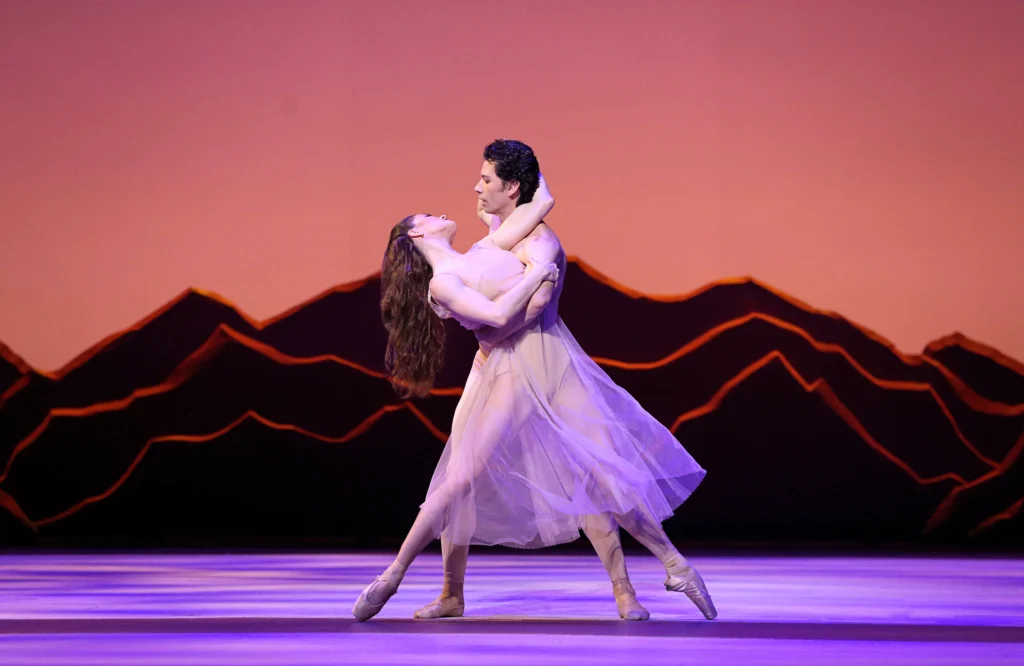
Christopher Wheeldon’s Like Water for Chocolate received its New York City premiere by American Ballet Theatre in June. The ballet adaptation of Mexican author Laura Esquivel’s beloved novel of the same name was a delicious treat for the senses. Joby Talbot’s original score was festive and cinematic, and Bob Crowley’s scenery and costumes were steeped in magical realism. But best of all were the opening-night performances of Cassandra Trenary as Tita and Herman Cornejo as Pedro. Trenary brought a tender vulnerability to Tita’s many heartbreaks, while Cornejo imbued Pedro’s complex character with a mature and dignified grace. Despite the occasionally tepid choreography, the pair’s chemistry was electric. In one pas de deux, the forbidden lovers danced among hanging laundry, almost-but-not-actually touching each other, exuding desire. Their decades-long love affair was portrayed with a depth that transcended the physical. At the end, the couple—finally free to be together—ascended into the higher realm and, even if just for a moment, took the audience with them. —Caedra Scott-Flaherty
New York City Ballet’s Emma Von Enck in “Rubies,” from Jewels
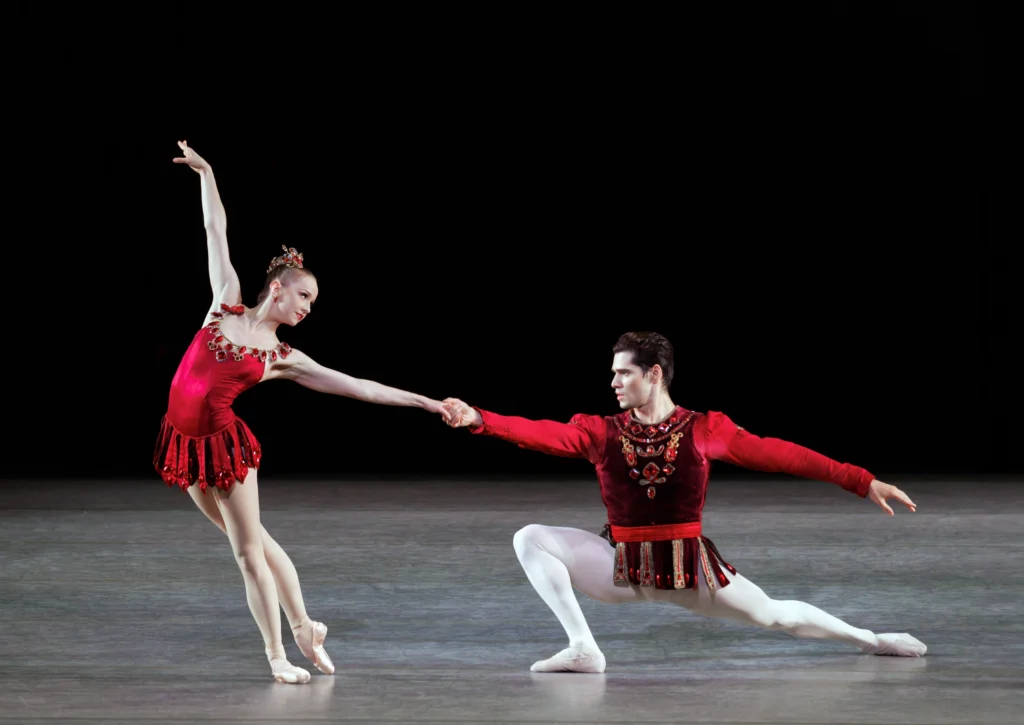
The three distinctive worlds from Balanchine’s Jewels are so recognizable they’ve given rise to their own archetypes, forms of balletic shorthand: This dancer is more of an “Emeralds” dreamer, that one a “Diamonds” queen. Performers and audiences alike are well-acquainted with the jaunty delights of the “Rubies” ballerina. And sometimes dancers can lean a little too hard into that familiarity, overplaying the role’s stylish flourishes.
But in her “Rubies” principal debut this September, New York City Ballet soloist Emma Von Enck pulled new meat out of an old chestnut. Her “Rubies” felt like playtime, in a genuinely childlike way: spontaneous, joyful, uninhibited. (The famous jump-rope break seemed entirely in character.) Her technique, on the other hand, looked thoroughly grown-up: incisive footwork, spring-loaded jumps, breezy ease in the knotty partnering.
Watching Von Enck, you forgot that you knew what was coming next—or that she did. Together, you were glorying in these steps, this role, this ballet, for the first time. —Margaret Fuhrer
Vitacca Ballet in Hypnotic Forces
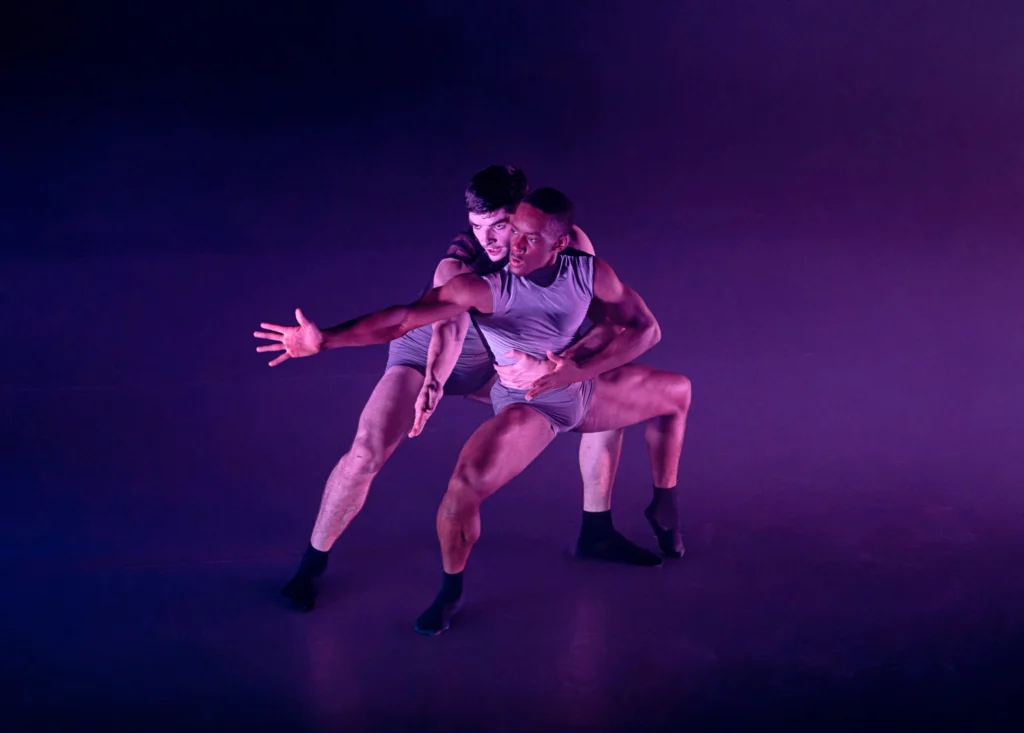
Vitacca Ballet’s connection with its choreographer in residence, Garrett Smith, was in full evidence during the October performance of his Hypnotic Forces, a tour-de-force exploration of hypervigilance. The dancers fully embodied Smith’s dive into a “ready state” with all-in commitment and unrelenting intensity. Developed over the course of a year, Hypnotic Forces showed off the Houston-based company’s raw verve, visceral drive, and impressive musicality amidst composer Nils Frahm’s pounding rhythms. Jordan Hooks and Joshua Ponton delivered a powerful concluding duet that oscillated between tenderness and anxious watchfulness, with a tension that never let up even during its most intimate moments. —Nancy Wozny
Joffrey Ballet’s José Pablo Castro Cuevas and Jonathan Dole in Frankenstein
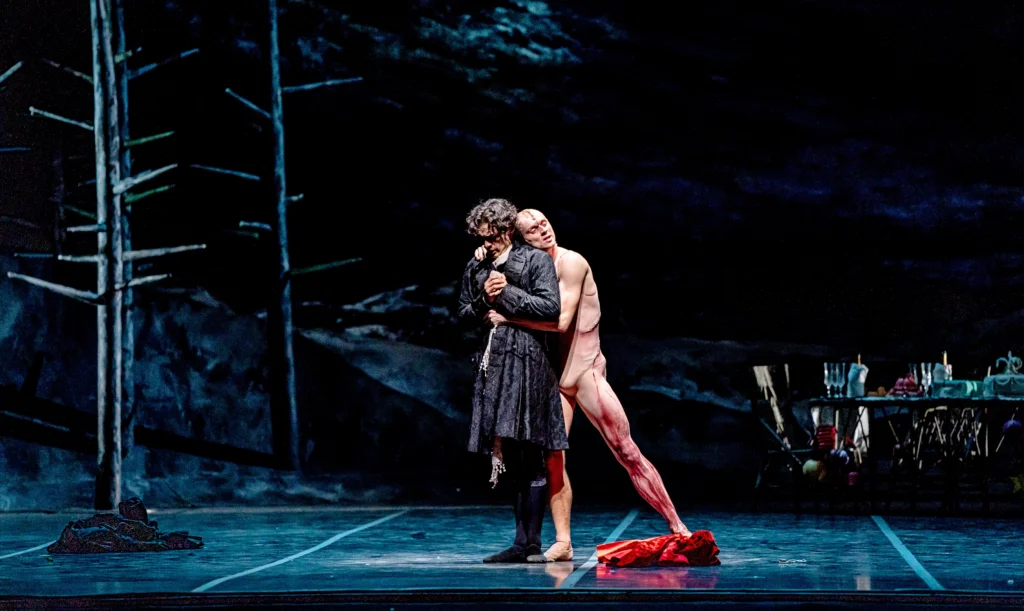
Joffrey Ballet’s revival of Liam Scarlett’s Frankenstein was bound to be emotional, but José Pablo Castro Cuevas and Jonathan Dole turned it up to 11 with explosive breakout performances as Victor Frankenstein and the Creature, respectively.
Cuevas has quietly risen through the company since his 2019 promotion from the Joffrey Academy of Dance, performing principal roles here and there—but never in an opening-night cast. The troubled titular chemist is an uncommonly demanding part, requiring youthful innocence and weathered maturity, fevered obsession, unabashed exuberance, and the depths of despair—plus lots of dancing—all in one night.
Dole, like Cuevas, joined the main company in 2019, though he hadn’t really emerged from the ensemble—until now. As Creature, he wrestled with a complex character that wriggles and writhes like a beast while carrying the physical and psychological weight of lousy circumstances and terrible deeds.
The ballet peaks with a heartbreaking pas de deux for the men, shortly before the dejected doctor, sick with grief, takes his life. The Joffrey has a deep bench of talented men, but with stunning dancing and the dramatic dominance of the Lyric Opera’s cavernous stage, Cuevas and Dole prove they’re here to play ball. —Lauren Warnecke
